Recent Articles
Popular Makes
Body Types
2016 Smart Fortwo First Drive and Review
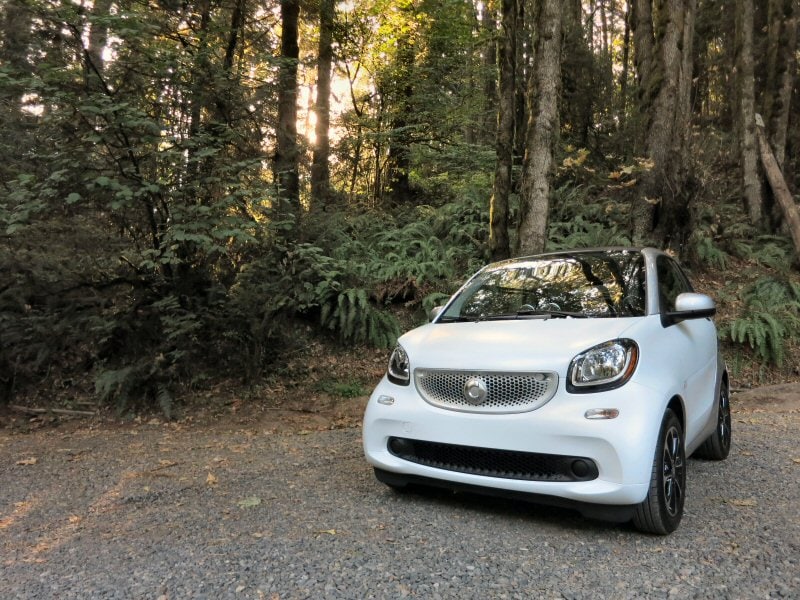
2016 Smart Fortwo front 3/4 ・ Photo by Benjamin Hunting
It's taken years, but Americans are finally starting to care about city cars, the name given to ultra-compact hatchbacks designed specifically to navigate the crowded, space-squeezed environs of a major metropolis. The 2016 Smart Fortwo has been redesigned at precisely the right time to take advantage of this newfound enthusiasm for small automobiles, a charge that's been lead by an influx of models like the Chevrolet Spark, the Fiat 500, and of course the long-popular MINI Cooper.
The Smart Fortwo stands apart from each of these potential rivals by making 'tiny' a virtue, as disappearance of the Scion iQ has rendered the Euro coupe the only two-passenger car in its class. I had the opportunity to sample the Smart in Portland, Oregon, a city that has traditionally counted acceptance of the unusual as one of its core values. Truncated in size, if not spirit when seen alongside its peers, I discovered that the new Fortwo rights some of the wrongs perpetrated by the brand's initial foray across the Atlantic and resolutely sticks to its guns that there exists a market for premium-priced entry-level fare.
Wider, But Not Longer
The temptation to make even a small car like the 2016 Smart Fortwo larger with each successive redesign must be great, but fortunately the designers at Mercedes-Benz (corporate parent to the Smart experiment) recognized that to trade footprint for interior volume would invalidate the Fortwo's entire raison d'être. As a result, the coupe still measures in at just a tick under nine feet long, matching the previous generation car and maintaining its unique ability to park facing the curb without jutting out into a roadway.
Where the Fortwo has grown is across the beltline, where it now houses a track that is 3.9 inches greater than its predecessor. This might not seem like much of a stretch, but it's enough to allow the front wheels to cut more aggressively when the Smart's steering is cranked all the way to one side or the other, resulting in an incredibly tight turning radius. It's possible to pull a U in the middle of almost any-size street, giving the Fortwo a versatility in tight traffic that's unavailable from larger city cars.
The extra width has also translated into a modest improvement in passenger space, and while the car is still anything but big once you've closed yourself inside, it never really feels Lilliputian out on the road, even for taller riders. Cargo room remains miniscule, with a drop-down tailgate at the rear of the Fortwo providing enough room for a trio of overnight bags. Anything more than that and you'll have to fold the front passenger seat forward and leave your buddy standing at the curb.
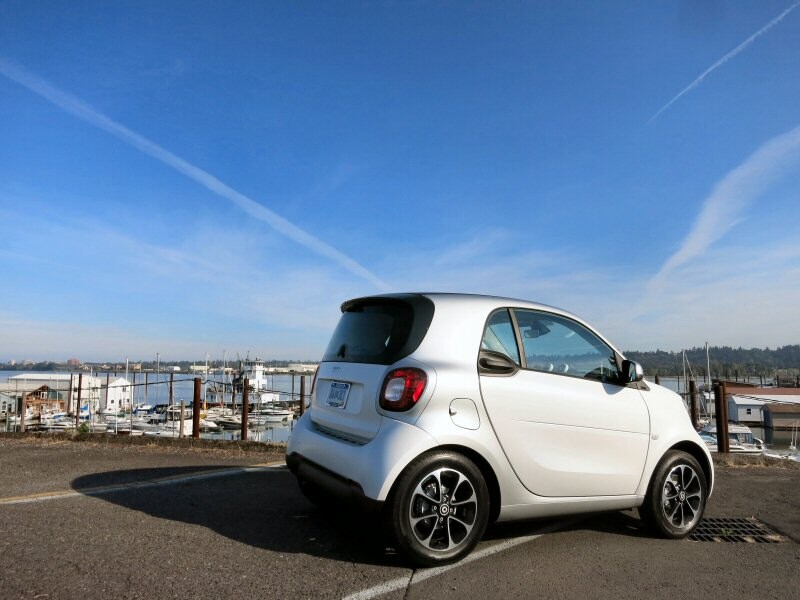
Photo by Benjamin Hunting
Turbo Power Wakes Up Performance
A small, lightweight car like the Smart Fortwo doesn't need much in the way of motivation to either inch forward in gridlock or keep up with the flow of urban traffic. Still, the first Smart to be foisted on Americans made do with a paltry 70 horses and 68 lb-ft of twist, numbers that even on paper look weak. For 2016 the Fortwo gains a new three-cylinder turbocharged engine that displaces a little less than a liter, and the move to forced induction has paid significant benefits: 89 horsepower and 100 lb-ft of torque are now on tap from the minuscule motor. On the downside, you'll have to fill the vehicle with premium fuel to enjoy the fruits of the turbo's labor.
Given that Smart Fortwo's engine is actually located at the very rear of the car (underneath its trunk), stepping down hard on the accelerator generates an aggressive whoosh as the turbo sucks in as much air as possible, accompanied by a mechanical thrashing the reminds you just how hard the sub-liter unit has to work to scoot you to 60-mph in a glacial 10.1 seconds. Numbers don't lie, but the only place I found the Fortwo's forward pace to be sub-par was on the highway, where acceleration past 40-mph is almost imperceptible unless you happen to be watching the gradual sweep of the car's speedometer.
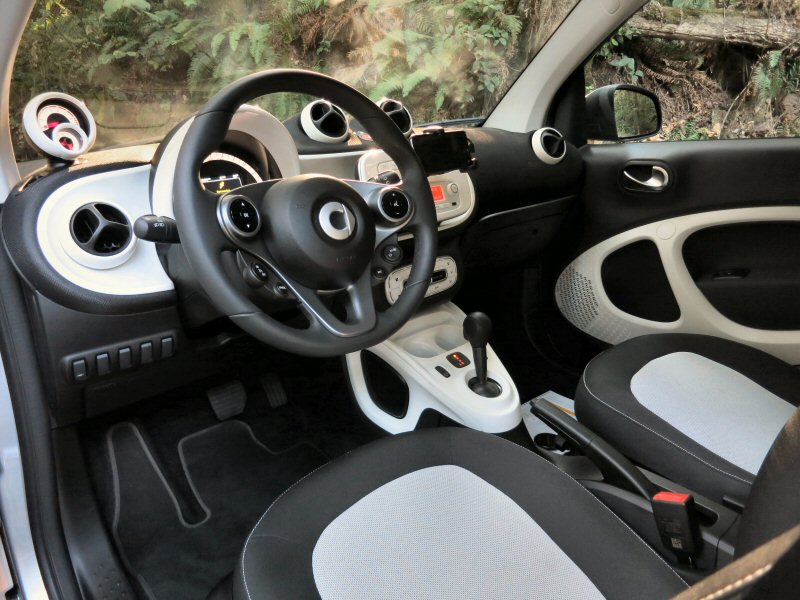
Photo by Benjamin Hunting
Two New Transmission Choices
Another area where the 2016 Smart Fortwo has made significant strides is in the transmission department. Banished is the balky, semi-automated manual setup that turned off so many would-be owners of the original Fortwo, and in its place are a pair of more pleasing options. Standard with the Smart is a five-speed manual gearbox, long available in Europe but making its first appearance State-side, and if you're willing to pay a little bit more the coupe can also be outfitted with a six-speed dual-clutch automated manual.
Priced at $990, Smart claims that its 'twinamic' transmission is the cheapest DCT available in America. After spending a day with the unit I can safely say that although it might be affordable there's no shame in the 6-speed's game, as it was largely transparent during our time together. I didn't have the chance to sample the manual, but using the shift-it-yourself mode on the dual-clutch wasn't exactly thrilling as the turbo three isn't an engine that likes to be hurried.
Sidebar: the Smart Fortwo is the only car Mercedes-Benz offers in the United States with a manual tranny for the 2016 model year.
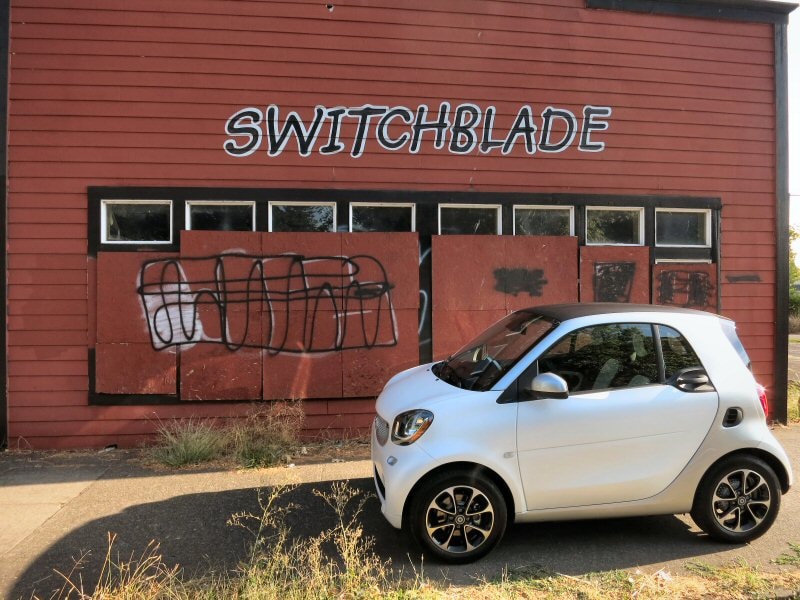
Unofficially, The Smart Fortwo Is As Frugal As Ever
Small car, smaller engine, and a choice between manual and dual-clutch gearboxes all points to the potential for respectable fuel efficiency from the Smart Fortwo. While the EPA has yet to certify the car's frugality, Smart told me that the coupe can be counted on to provide 33-mpg in city driving and 39-mpg on the highway when equipped with the six-speed, with the five-speed dropping only a single mile per gallon from the city measure. Total combined fuel mileage for the Fortwo is listed at 36-mpg, maintaining the status quo for the commuter despite its newly amped-up engine.
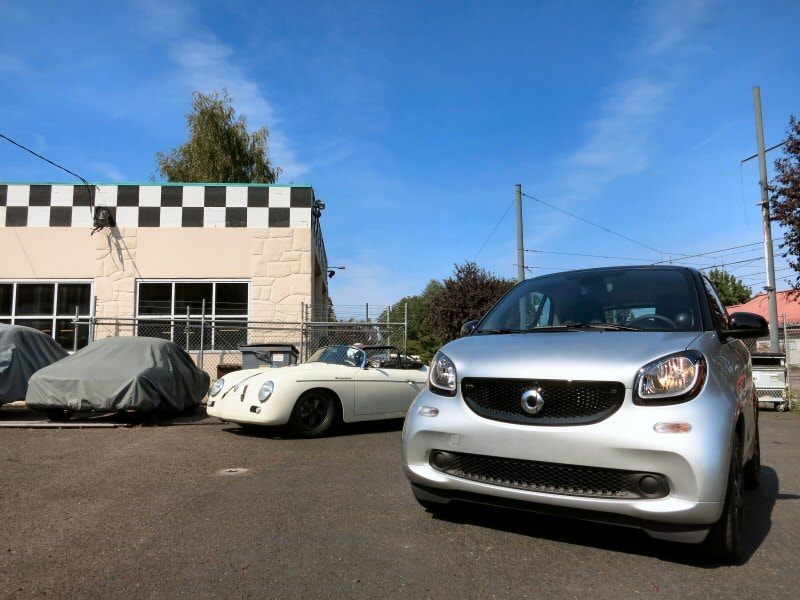
Photo by Benjamin Hunting
The Fortwo Wears Its 'Fun But Not Sporty' Shackles Well
With a wheels-at-four-corners chassis, a turbocharged engine, and a surprising-for-its-segment rear-wheel drive layout, the 2016 Smart Fortwo might seem like it has the potential to be more sporty than its modest market position indicates. Sadly, this is not the case, as Smart engineers have elected to keep the Fortwo on a very tight electronic leash in the interests of protecting drivers from any nasty surprises related to the short-wheelbase car's engine position.
Chasing the devil that is oversteer from the Fortwo's pews has forced the coupe to engage its stability control system rather aggressively should you attempt to apply full throttle with the wheel tilted even slightly in either direction. Intervention comes in the form of reduced throttle response, sometimes to the point where the vehicle barely even moves until you reduce either steering or accelerator inputs.
It's impossible to turn off the Smart car's digital straightjacket, but fear not: while the sensor-setup might deprive you of hooliganish antics (even parking brake slides are verboten with the Fortwo), the vehicle remains surprisingly pleasant to drive when piloted within the limits of reason. Even some of the hillier roads surrounding Portland proved to be no challenge to the car's suspension, which has been tuned to improve comfort over the older model.
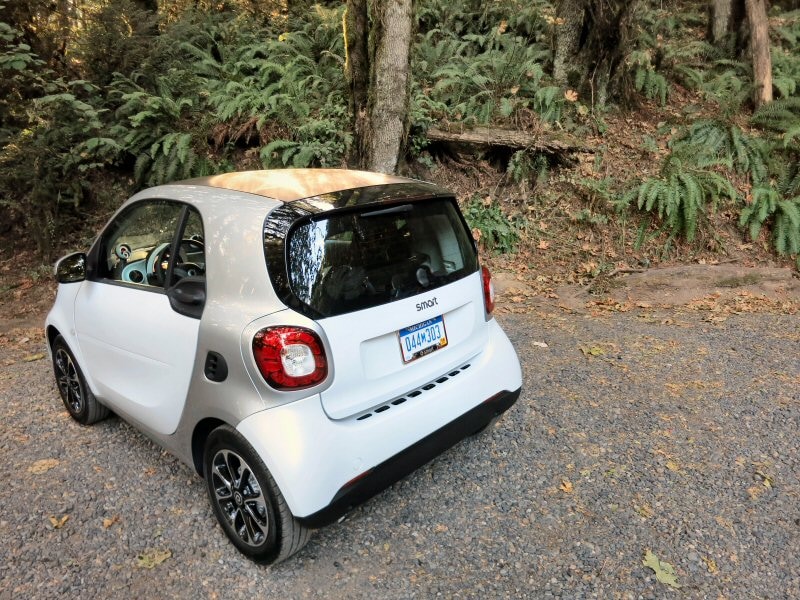
Photo by Benjamin Hunting
Updates Brighten Coupe's Interior, Modernize Exterior Styling
The 2016 Smart Fortwo's Mini-Me palette almost guarantees polarizing styling, but even though the new coupe hasn't physically grown all that much the exaggeration of certain visual aspects - the hood, the grille, the headlights, and the painted handlebar that rises up along each side of the vehicle - imparts a sense of size and solidity that should draw in more buyers. I also appreciated just how many colors Smart offers with the car, a move that is in keeping with its extroverted character but one that has been sadly abandoned of late even by manufacturers of sporty cars in favor of more boring shades of silver and grey.
Inside it's a similar story. Although still clearly assembled to respect a well-delineated budget, the Fortwo's places new emphasis on a visually distinctive dashboard and door panel arrangement that doesn't cross the line into gimmickry (there's also a nice LCD display tucked just under the speedometer that shows a variety of vehicle data readouts). The same can't be said of the swivel tach mounted to the left of the driver's binnacle, which, due to an amusing side effect of multi-market parts sharing, can be turned to face completely outside the car.

Photo by Benjamin Hunting
Four Trim Levels, Many Options
Leaving aside the upcoming Smart EV, there are four trim levels available when ordering the 2016 Smart Fortwo. The entry-level Pure (MSRP $14,650) offers standard Bluetooth, cruise control, and LED daytime running lights, while the Fortwo Passion (MSRP $16,140) adds a heated side mirrors, a leather-wrapped steering wheel, and upgraded 15-inch wheels. Move to the Prime trim (MSRP $17,490) and you get a host of goodies: heated seats, foglights, leather upholstery, and a sunroof, while the top-tier Fortwo Proxy (MSRP $18,480) loads up with 16-inch wheels, louder stereo, a sport appearance package that includes a lowered suspension system and paddle shifters for the DCT, and distinct interior trim. As a bonus, many of these features can be ordered as individual options or as part of packages, including the unusually-named 'Man-made leather upholstery' that is certain to upset proud robot artisans the world over. It's very easy to outfit the Fortwo exactly as you'd like, and with the startling array of replaceable body panel colors thrown in the Smart is a perfect platform for personalization.
Safety has also been prioritized more than one might expect in the subcompact coupe. The Fortwo offers a standard cross-wind assist feature that uses the vehicle's brakes to help keep its tall greenhouse tracking straight and true on blustery roads, and there's even a forward collision warning system ported over from Mercedes-Benz that can be installed on the car.
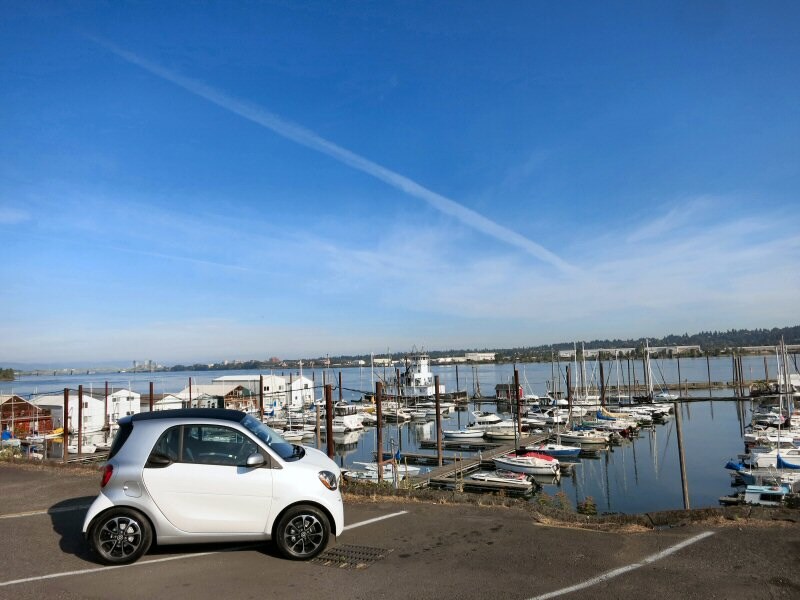
Photo by Benjamin Hunting
Smart Cross Connect Still In Beta, Still Needs Refinement
Each of the 2016 Smart Fortwos that I drove in Portland was equipped with the $100 smartphone dock that facilitates the use of the brand's Smart Connect system. Smart Connect aims to deliver cheap software services to the masses, and it includes navigation, music streaming, parking spot locator capability, and even toys like a g-meter once you're got your mobile device linked to the car. It sits directly in front of the radio controls and in effect supplants them (although it's still possible to order an integrated LCD infotainment system with the car if you want one).
We were cautioned that Cross Connect was still in beta, but even without that warning it was clear that the system wasn't quite ready for primetime. During the drive the demo phones would randomly begin playing music, sometimes right overtop of an FM radio broadcast, but usually triggered whenever the car was turned off (or, strangely, when the rear hatch was opened). The navigation feature was also predisposed to long detours and wasn't all that accurate at letting me know when we needed to make an upcoming turn, a handicap that added an extra layer of challenge to the scavenger hunt through the city that Smart had organized. While the cost of entry is cheap, I'm hopeful that the brand's coders will be able to work out some of the bugs before the car goes on sale this fall.
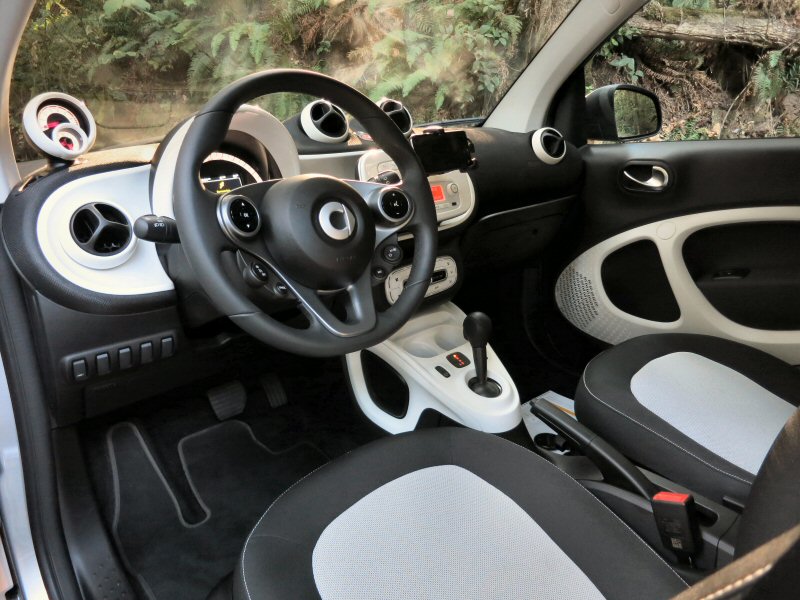
Photo by Benjamin Hunting
2016 Smart Fortwo Pros / Cons
Pros:
- More power, but still frugal
- Sharper looks
- Improved ride quality
- You can park it anywhere
- Excellent options and features availability
- Pleasant to drive
Cons:
- Cross Connect feature still buggy in beta
- Not at all sporty due to strict stability control program
- Tiny cargo capacity
- Neighborhood kids might be tempted to tip it over
- Expensive compared to much more practical four-door, four-passenger options
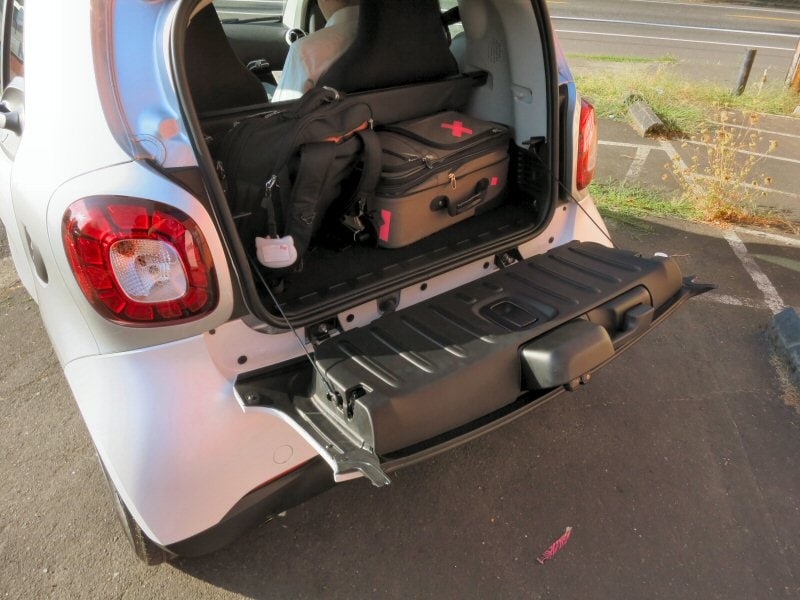
Photo by Benjamin Hunting